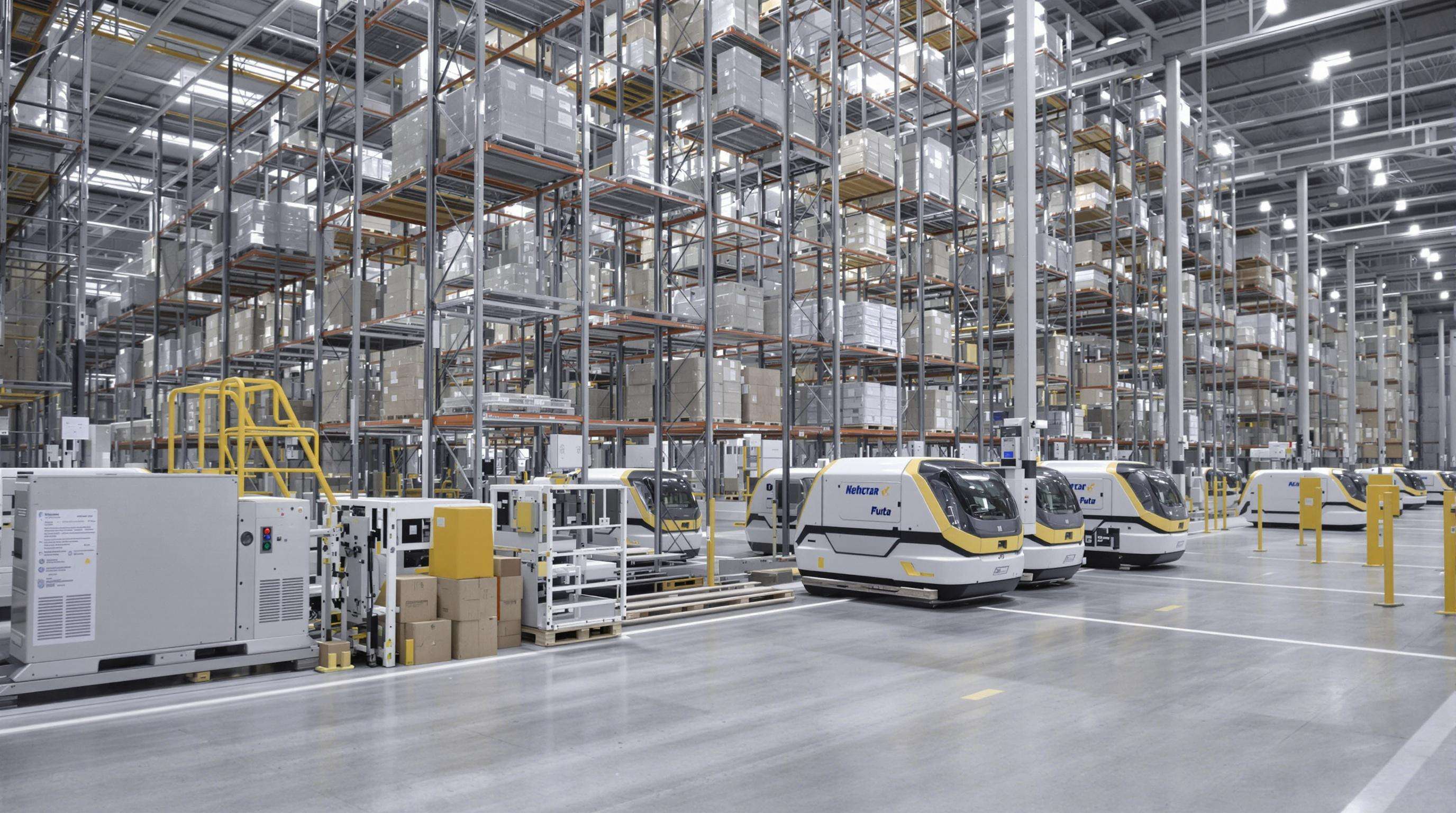The Evolution of Pallet Machine Maker: Driving Efficiency in Modern Supply Chains

Growing Demand for Automation in Global Pallet Production
The combination of worker shortages and climbing operating expenses is pushing more pallet manufacturing plants toward automation around the globe. Online shopping has exploded in recent years, creating pressure for quicker delivery times and consistent product quality that just isn't possible with traditional labor methods when dealing with large volumes. Automated systems simply outperform humans in terms of accuracy and can run nonstop without breaks. According to various industry analyses, installation of automated machinery has grown at over 10% per year since early 2020. Pallet equipment manufacturers have been pouring money into research and development as they recognize this growing trend in their sector.
Core Technologies Powering Automated Pallet Machines
Modern automated pallet systems integrate synchronized robotic components to ensure precision and reliability:
- High-speed multi-axis robotic arms for accurate nailing and stacking
- Computer vision systems that detect wood grain patterns and defects
- Integrated pressure sensors maintaining optimal fastener torque
- Self-adjusting conveyor systems compensating for material variance
- Programmable pallet dimension controllers
These technologies enable consistent quality across thousands of daily pallets. A leading European pallet machine maker recently enhanced its systems with force-feedback technology that adapts to hard knots in reclaimed timber, improving durability and reducing waste.
IoT and AI Integration in Palletizing Systems
Sensors connected to the Internet of Things keep track of vibrations, temperatures, and how much power machines are using. This helps factories spot problems before they happen, cutting down on those annoying surprise breakdowns. Smart computer programs work alongside warehouse management systems to figure out what needs doing first on the production line. Plants that have adopted these predictive tools often see around a third less downtime from broken equipment. And let's not forget about those camera systems watching over assembly lines these days. They catch nearly all stacking mistakes automatically these days, which means fewer defective products going out the door and smoother operations overall for manufacturers.
Case Study: Boosting Throughput in a High-Volume Distribution Center
A Midwest U.S. retail distributor implemented automated nailing technology and achieved transformative results:
- Production increased from 280 to 420 pallets/hour
- Rejected pallet rates dropped by 68%
- Labor injuries decreased by 100% over 18 months
- ROI was achieved in under 14 months
By replacing manual stations with integrated loading systems, operators now manage three production lines simultaneously via unified dashboards. This shift exemplifies how pallet machine makers turn throughput bottlenecks into competitive advantages.
Customized Pallet Solutions for Diverse Industrial Applications
Meeting Unique Production Needs with Custom Pallet Design
The automotive, pharmaceutical, and food processing sectors all need special pallets made specifically for how they operate day to day. These custom built pallets can handle weights of around 3,000 kilograms, work across temperatures ranging from minus 30 degrees Celsius right up to 80 degrees, and fit exactly into automated systems where size matters. Take food processing plants for instance many of them now use pallets coated with antimicrobial treatments to keep bacteria at bay. Meanwhile in electronics manufacturing, companies go for ESD safe materials because even a small spark from static electricity can ruin sensitive components. Recent research published last year shows that when businesses invest in these tailor made solutions, they tend to see product losses drop by roughly 27 percent plus warehouses generally make better use of available storage space as well.
Modular Engineering Approaches by Pallet Machine Makers
Leading manufacturers utilize modular engineering to support rapid reconfiguration for changing production needs. Key features include:
- Swappable frames for multiple pallet sizes (1200x800mm to 1400x1140mm)
- Scalable throughput from 100 to 500 pallets/hour
- Material-agnostic tooling compatible with wood, plastic, and composites
- Adaptive control interfaces for quick programming
This approach reduces changeover times by 70% compared to fixed systems, allowing seamless transitions between standard and custom pallet production within a single shift.
Case Study: Tailored Pallet Handling for an Automotive Parts Manufacturer
A European auto parts supplier experienced 15% pallet breakage due to inadequate oil resistance and poor load distribution. To address this, they co-developed composite pallets featuring:
- Reinforced rib structures supporting 2,200kg loads
- Petroleum-resistant polymer coatings
- Forklift-engagement notches compatible with automated guided vehicles (AGVs)
Results included a 60% reduction in material waste, 22% faster loading cycles, and monthly production downtime reduced by 30 hours. The solution also integrated smoothly with existing automation infrastructure.
Co-Designing Automation Equipment with End Users for Optimal Fit
Smart pallet machine manufacturers actually go to client sites early on in the design phase to look at how things work there. They check out important stuff like where robotic arms need space to move and what kind of tolerance levels are needed for stacking operations. When companies take this hands-on approach together with their clients, it means the machines fit better into existing facilities right from day one. We've seen this cut down on those frustrating changes after installation by around 40 percent in many cases. For plant managers, getting machinery that works well within their current setup makes all the difference. The equipment doesn't stick out like a sore thumb but rather becomes part of the whole operation, which leads to better results overall and definitely pays off financially in the long run.
Innovations in Material Handling: From Pallet Nailing Lines to Smart Shuttles

Key Innovations in Automated Pallet Assembly Equipment
Today's pallet machine manufacturers are increasingly turning to vision guided robotic arms that can place fasteners with around 0.1mm accuracy, which has cut down on wood waste by roughly 18% when compared to older techniques. The modular nailing systems now available let operators switch from making block pallets to stringer pallets within just about 15 minutes flat, slashing the time needed for reconfiguration by nearly three quarters. These improvements aren't isolated incidents either but part of what we're seeing across the board in automated material handling solutions. Manufacturers are really starting to embrace this kind of flexibility as supply chains become more unpredictable day by day.
Transitioning from Manual to Fully Automated Packaging Systems
Operators upgrading from legacy workflows achieve up to 95% defect reduction through integrated quality gates using laser scanners and load-test simulations. One automotive supplier eliminated manual sorting errors entirely after implementing AI-driven defect detection, cutting annual return costs by $2.4 million.
Convergence of Manufacturing and Logistics Automation Platforms
Leading systems now synchronize pallet production schedules with warehouse shuttle availability via unified IoT dashboards. This integration reduces buffer inventory by 32% while maintaining 99.6% same-day fulfillment rates, even during peak seasonal demand.
The Rise of Autonomous Pallet Shuttles and Dynamic Storage
Smart pallet shuttle systems have demonstrated 60% higher storage density in frozen warehouses through deep-lane automation. AI-optimized routing reduces energy consumption by 22% per retrieval cycle, with temperature-controlled variants maintaining ±0.5°C stability—critical for pharmaceutical cold chains.
Balancing Standardization and Customization in Automated Pallet Systems
Impact of Automation on Pallet Structural Design and Load Requirements
When it comes to automation, there's simply no room for error anymore. Robotic handlers need parts that are dimensionally accurate within about 1.5mm if they're going to work properly without constant adjustments. Engineers have responded by making some pretty significant upgrades to materials and design features. We're seeing things like reinforced deck boards and those neat little chamfered edges on components which really help keep things moving smoothly along high speed production lines. The rise of automated storage and retrieval systems has changed everything too. Today's systems handle an average load capacity of around 2,200 kilograms per pallet, way ahead of what manual handling could ever manage back in the day. And let's not forget just how expensive mistakes can get when precision goes out the window. A single deviation from specifications might seem small, but it can actually bring entire operations grinding to a halt, with repair costs running into hundreds of thousands each year according to industry reports from IMA in 2023.
Case Study: Redesigning Pallets for Automated Forklift Compatibility
A European distributor faced 15% pallet damage rates when adopting automated forklifts, as legacy designs could not withstand the centering forces applied by robotic arms. In collaboration with equipment engineers, they redesigned pallets with thicker stringers (increased from 18mm to 25mm) and optimized base profiles. The updated design:
- Reduced damage to 3% within three months
- Increased throughput by 22% due to smoother handling
- Achieved full compatibility with narrow-aisle robotic forklifts operating at 12 seconds per cycle
While the new pallets were 5% heavier, the trade-off delivered significant gains in automation reliability and return on investment.
Standardization vs. Customization: Strategic Trade-offs for Pallet Machine Makers
Manufacturers of pallet machines are stuck between a rock and a hard place. Standardized equipment brings quicker returns on investment thanks to mass production benefits, but these systems just don't cut it when clients have special requirements. On the flip side, custom built solutions work great for specialized applications like temperature controlled storage in the pharmaceutical industry, though they typically push manufacturing costs up somewhere around 30 to 40 percent. Most companies find themselves somewhere in the middle with what we call a mixed approach. Think of it as building from standard parts but adding interchangeable modules for things like different nail configurations, clamping mechanisms, or how materials get handled during assembly. This middle ground covers about four out of five customer requests without blowing the budget on research and development, which stays under roughly 15% of total revenue. Makes sense really, especially considering warehouse automation is growing at something like 8 point something percent year over year according to LogisticsIQ last year.
FAQ Section
What technologies are used in modern automated pallet systems?
Modern automated pallet systems utilize synchronized robotic components, high-speed multi-axis robotic arms, computer vision systems, integrated pressure sensors, self-adjusting conveyor systems, and programmable pallet dimension controllers.
How have IoT and AI influenced pallet automation?
IoT and AI integration allows for monitoring vibrations, temperatures, and power usage, enabling predictive maintenance and reducing equipment downtime. AI-driven systems also improve defect detection and optimize production line tasks.
What benefits do customized pallets offer to industries like food processing and electronics manufacturing?
Customized pallets are tailored to meet specific industry needs, such as antimicrobial treatments for food processing to reduce bacteria and ESD-safe materials for electronics manufacturing to protect sensitive components.
What challenges do pallet machine manufacturers face with standardization vs. customization?
Manufacturers face a trade-off between quicker ROI with standardized equipment and customized solutions for specialized applications, which is often more costly but necessary for unique client requirements.
Table of Contents
- The Evolution of Pallet Machine Maker: Driving Efficiency in Modern Supply Chains
- Customized Pallet Solutions for Diverse Industrial Applications
- Innovations in Material Handling: From Pallet Nailing Lines to Smart Shuttles
- Balancing Standardization and Customization in Automated Pallet Systems
-
FAQ Section
- What technologies are used in modern automated pallet systems?
- How have IoT and AI influenced pallet automation?
- What benefits do customized pallets offer to industries like food processing and electronics manufacturing?
- What challenges do pallet machine manufacturers face with standardization vs. customization?


